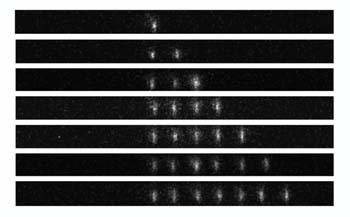
Sorting Atoms for Quantum Computing
Optical trapping technique rearranges atoms with precise spacing.
Anne L. Fischer
Strings of laser-trapped atoms can be useful for storing and processing quantum information. Recently, researchers at the University of Bonn in Germany used an optical trapping technique to rearrange atoms in such strings with submicrometer precision to change their order.

In this fluorescent image of strings, up to seven ultracold cesium atoms are shown trapped in the intensity maxima of a standing-wave laser beam. The strings have been made equidistant by rearranging the positions and the order of the atoms using an optical trapping technique.
According to Arno Rauschenbeutel, senior researcher at the university, to process quantum information, it is necessary to control the interaction between neighboring atoms. This can be done by inserting the atoms into an optical resonator where they can exchange photons.
Previous groups have worked with larger ensembles of atoms. In contrast, the Bonn investigators worked with single atoms, individually addressing and resolving the atoms optically and then rearranging them with optical “tweezers” made of two counterpropagating laser beams.
The new method cools cesium atoms to ∼100 μK inside a vacuum chamber and stores them in the antinodes of a standing-wave laser beam. Initially, the trapped atoms are randomly distributed over the antinodes and form a string. The researchers recorded a fluorescence image using a custom-built microscope objective and an intensified CCD camera with an image intensifier, both from Roper Scientific of Tucson, Ariz. They used the image to determine the position of each atom. By using two dipole trap lasers from Quantronix of East Setauket, N.Y., focused to a diameter of 40 μm, they could subsequently move the atoms along the string and rearrange them with nanometer precision.
In this way, a scalable, neutral-atom quantum register might be developed for quantum information processing. To process this information, however, would require a quantum logic gate; that is, the quantum analog of a two-bit logic operation in a classical computer. The researchers are working on this by forcing the atoms to exchange photons inside an optical resonator. Rauschenbeutel believes that it is possible to use this method to develop a quantum simulator, which could solve problems of physics that cannot be simulated with a traditional computer
Nature, July 13, 2006, p. 151.
Published: September 2006